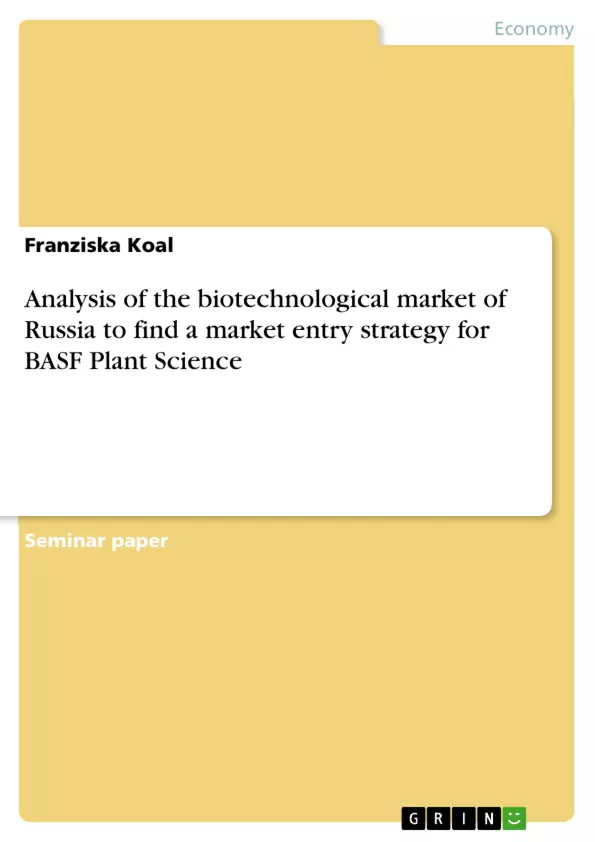BASF, the biggest chemical company in the world is now innovating and concentrating on one of their key fields: plant biotechnology. This composition is going to analyse whether the Russian market, especially the biotechnological market of Russia is compatible to the high agenda of BASF. Chances and Risks should complete the view of Russia as a potential market for the plant biotechnology branch of BASF and its subsidiary BASF Plant Science.
Inhaltsverzeichnis (Table of Contents)
- Introduction
- Basic information
- Biotechnology
- The company BASF
- BASF and plant biotechnology
- BASF Plant Science
- Russia
- Key data
- Historical background
- Characterization according to Geert Hofstede
- Russia's plant biotechnology market
- Market entry strategy
- Chances
- Risks
- Recommendation
- Quellenverzeichnis
Zielsetzung und Themenschwerpunkte (Objectives and Key Themes)
This paper aims to analyze the potential of the Russian market, specifically the biotechnological market, for BASF Plant Science. It explores the compatibility of the Russian market with BASF's high-level agenda, examining opportunities and risks associated with entering this market.
- Analysis of Russia's biotechnology market
- Evaluation of BASF Plant Science's potential for market entry in Russia
- Identification of opportunities and challenges in the Russian biotechnology market
- Assessment of the compatibility of the Russian market with BASF's strategic goals
- Development of recommendations for a successful market entry strategy
Zusammenfassung der Kapitel (Chapter Summaries)
- Introduction: This chapter provides a brief overview of the topic and outlines the paper's objectives. It highlights BASF's focus on plant biotechnology and the importance of analyzing Russia's potential as a market for this branch of the company.
- Basic Information: This section provides a detailed explanation of biotechnology, including its definition, historical development, and various application areas. It also introduces BASF as a leading chemical company with a strong focus on plant biotechnology.
- Russia: This chapter presents a comprehensive overview of Russia, focusing on key data, historical background, cultural characteristics, and the state of Russia's plant biotechnology market.
- Market Entry Strategy: This section explores the potential opportunities and risks associated with BASF Plant Science entering the Russian market. It analyzes the factors that could contribute to the success or failure of a market entry strategy.
Schlüsselwörter (Keywords)
The key keywords and focus topics of this paper include plant biotechnology, BASF, market entry strategy, Russia, opportunities, risks, biotechnology market, Geert Hofstede, cultural analysis, and strategic goals.
- Citar trabajo
- Franziska Koal (Autor), 2007, Analysis of the biotechnological market of Russia to find a market entry strategy for BASF Plant Science, Múnich, GRIN Verlag, https://www.grin.com/document/146558



